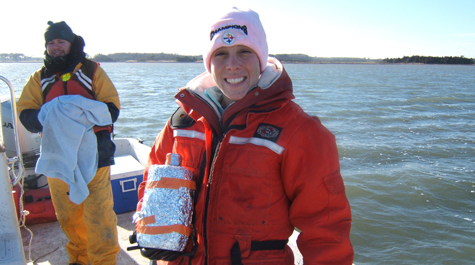VIMS grad student wins presentation award
Graduate student Juliette Poleto Giordano of the Virginia Institute of Marine
Science, College of William and Mary, won the award for outstanding student
oral presentation at the spring meeting of the Atlantic Estuarine Research
Society (AERS) in Ocean City, MD.
Giordano, who recently completed her Master's degree with
Professors Mark Brush and Iris Anderson, presented results from her study of
nutrient pollution in the seaside lagoons of the Delmarva Peninsula. Her
findings have potential implications for management actions to address nutrient
pollution in the region.
Giordano's study involved comparing nutrient enrichment in
Virginia's coastal lagoons, which are generally considered relatively pristine,
with the lagoons of Delaware and Maryland, whose watersheds are more heavily
impacted by urban development and large-scale agriculture.
The results of her computer modeling and field studies were surprising. They showed that some Virginia lagoons actually receive high inputs of nitrogen, most likely from fertilization of nearby farm fields, but that their water quality is less affected by this "nutrient loading" than the highly impacted lagoons of Delaware and Maryland.
Earlier studies show that high inputs of nitrogen to the Delaware and Maryland lagoons lead to excessive growth of algae and related declines in water quality¬what scientists term "eutrophication." The Virginia lagoons, on the other hand, had less algae and lower nitrogen concentrations.
"We're still not exactly sure why our lagoons are behaving differently," says Giordano. "It may be because they are more effectively flushed by incoming seawater, or because nitrogen is being taken up by benthic algae."
Benthic algae, which grow on the bottom, have been shown to be effective "nutrient traps" in shallow systems. The abundance of benthic algae in Virginia's lagoons, and their ability to at least temporarily reduce over-fertilization of these waters by nitrogen, may help explain the unexpectedly higher water quality in these systems.
The lagoons of Delaware and Maryland are dominated by floating, single-celled algae, or phytoplankton. These floating plants reduce water clarity and can lead to low-oxygen conditions when they die, sink, and decompose.
Turbid water and insufficient oxygen for marine life are two of the most significant problems facing coastal waters.
Pending continued funding, Giordano would like to continue studying these coastal lagoons as a Ph.D. student to further clarify their response to nutrient enrichment.
The Atlantic Estuarine Research Society (AERS) brings together students, scientists, managers, and educators from the states of DE, MD, NC, NJ, PA, and VA and Washington, DC to discuss estuarine and coastal environmental issues and policies.
The theme of the 2008 AERS meeting was "Clash of the Populations: Emerging Challenges for Coastal Lagoons." Giordano presented in the "Adjacent Land Use" session.
 Skip to main content
Skip to main content

